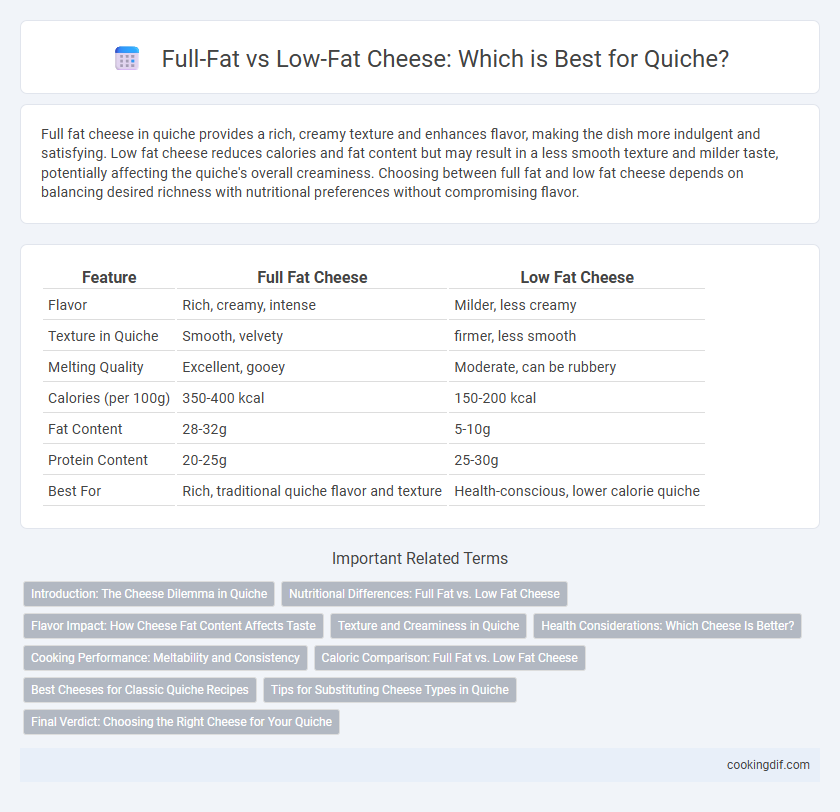Full fat cheese in quiche provides a rich, creamy texture and enhances flavor, making the dish more indulgent and satisfying. Low fat cheese reduces calories and fat content but may result in a less smooth texture and milder taste, potentially affecting the quiche's overall creaminess. Choosing between full fat and low fat cheese depends on balancing desired richness with nutritional preferences without compromising flavor.
Table of Comparison
| Feature | Full Fat Cheese | Low Fat Cheese |
|---|---|---|
| Flavor | Rich, creamy, intense | Milder, less creamy |
| Texture in Quiche | Smooth, velvety | firmer, less smooth |
| Melting Quality | Excellent, gooey | Moderate, can be rubbery |
| Calories (per 100g) | 350-400 kcal | 150-200 kcal |
| Fat Content | 28-32g | 5-10g |
| Protein Content | 20-25g | 25-30g |
| Best For | Rich, traditional quiche flavor and texture | Health-conscious, lower calorie quiche |
Introduction: The Cheese Dilemma in Quiche
Choosing between full fat and low fat cheese significantly impacts the texture and richness of quiche. Full fat cheese delivers a creamy, velvety consistency and enhances flavor depth, while low fat cheese offers a lighter option but can result in a drier, less cohesive filling. The decision hinges on balancing indulgence with dietary preferences without sacrificing the classic custard-like quality of traditional quiche.
Nutritional Differences: Full Fat vs. Low Fat Cheese
Full fat cheese in quiche offers higher caloric content and richer flavor due to increased saturated fat, enhancing taste and texture. Low fat cheese contains fewer calories and less saturated fat, making it a lighter option but potentially compromising creaminess and mouthfeel. Choosing between full fat and low fat cheese impacts the nutritional profile and sensory experience of the quiche.
Flavor Impact: How Cheese Fat Content Affects Taste
Full-fat cheese enhances the quiche with a rich, creamy texture and a bold, robust flavor that melts smoothly into the custard, intensifying the overall taste experience. Low-fat cheese tends to be drier and less flavorful, which can result in a quiche that feels less indulgent and has a milder, sometimes rubbery mouthfeel. Choosing full-fat cheese is essential for achieving the classic, savory depth and luscious consistency that define an authentic quiche.
Texture and Creaminess in Quiche
Full fat cheese enhances quiche with a richer, creamier texture by contributing higher moisture and fat content that melts smoothly during baking. Low fat cheese results in a firmer, less creamy quiche, often yielding a slightly rubbery texture due to reduced fat and moisture levels. Choosing full fat cheese improves the overall mouthfeel and softness, essential for the classic silky consistency of quiche.
Health Considerations: Which Cheese Is Better?
Full-fat cheese provides a richer flavor and creamier texture to quiche, but it contains higher levels of saturated fat and calories, which may impact heart health when consumed in excess. Low-fat cheese offers a lower calorie and fat content, making it a healthier choice for those managing weight or cholesterol levels, though it may result in a less creamy texture. Choosing between full-fat and low-fat cheese for quiche depends on balancing taste preferences with dietary goals and nutritional needs.
Cooking Performance: Meltability and Consistency
Full-fat cheese melts more evenly in quiche, creating a creamy and smooth consistency that enhances the overall texture. Low-fat cheese tends to release more moisture during baking, often leading to a watery or grainy quiche filling. Choosing full-fat cheese improves meltability and results in a richer, more cohesive final dish.
Caloric Comparison: Full Fat vs. Low Fat Cheese
Full-fat cheese contains approximately 80-100 calories per ounce, offering a richer flavor and creamier texture for quiche, while low-fat cheese typically has 40-60 calories per ounce, making it a lower-calorie alternative. Choosing full-fat cheese increases the overall calorie content of the quiche, which may impact dietary goals but enhances taste and mouthfeel. Low-fat cheese provides a healthier option with reduced saturated fat and calories but can result in a less creamy quiche texture.
Best Cheeses for Classic Quiche Recipes
Full-fat cheeses such as Gruyere, Emmental, and aged cheddar provide a rich, creamy texture and deep flavor that enhances classic quiche recipes. Low-fat cheeses lack the fat content necessary for smooth melting and can result in a dry, crumbly quiche filling. For an authentic taste and optimal texture, full-fat cheeses remain the best choice for traditional quiches.
Tips for Substituting Cheese Types in Quiche
Using full-fat cheese in quiche enhances creaminess and enriches flavor, while low-fat cheese offers a lighter option but may result in a drier texture. To maintain moisture when substituting low-fat cheese, incorporate a tablespoon of heavy cream or sour cream into the egg mixture. Opt for cheeses like Gruyere, Swiss, or cheddar, which melt well and provide balanced taste profiles in both full-fat and reduced-fat varieties.
Final Verdict: Choosing the Right Cheese for Your Quiche
Full fat cheese offers a richer, creamier texture and more intense flavor, enhancing the quiche's overall taste and mouthfeel. Low fat cheese provides a lighter option with fewer calories but can result in a less creamy consistency and milder flavor profile. For an optimal quiche, choosing full fat cheese such as Gruyere or aged cheddar delivers superior texture and taste, while low fat cheese may suit those seeking a healthier alternative without sacrificing structure.
full fat vs low fat cheese for quiche Infographic

 cookingdif.com
cookingdif.com